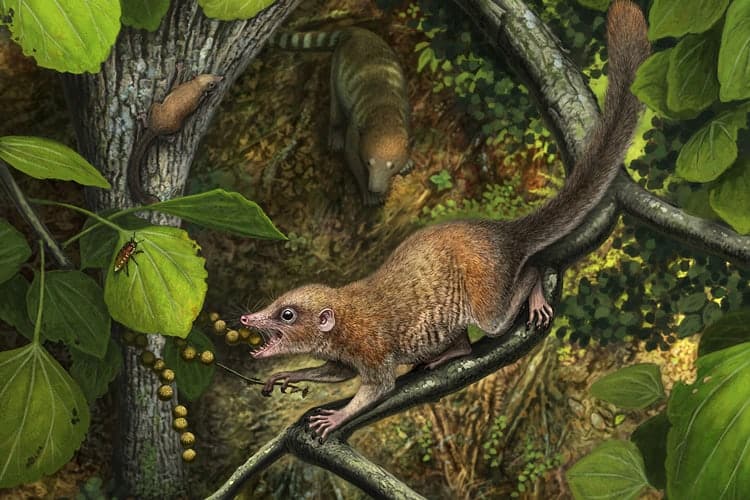
The small, furry ancestors of all primates — a group that includes humans and other apes — were already taking to the trees a mere 100,000 years after the mass extinction that wiped out the dinosaurs and most other terrestrial animals, according to a new analysis of fossil teeth in the collections of the University of California Museum of Paleontology (UCMP).
The analysis showed that the teeth are the earliest-known fossil evidence of any primate, dating from about 65.9 million years ago — 105,000 to 139,000 years after Cretaceous-Paleogene boundary 66 million years ago that signaled the end of the dinosaur era, except for the dinosaurs’ descendants, the birds.
The teeth and upper and lower jawbones, from a genus of mammals known as Purgatorius — the oldest genus in a group of now extinct early primates called plesiadapiforms — were collected over the past two decades from the Hell Creek region of northeastern Montana, south and east of Fort Peck Reservoir. The area is known for its T. rex and Triceratops fossils, but also for some of the earliest fossil mammals.
Based on the age of the fossils, the research team estimates that the ancestor of all primates — a group that also includes today’s lemurs and monkeys — likely emerged by the Late Cretaceous and lived alongside large dinosaurs.

High resolution CT scans of an assortment of fossilized teeth and jaw bones of Purgatorius from UCMP’s collection. (Image courtesy of Gregory Wilson Mantilla and Stephen Chester)
“It’s mind-blowing to think of our earliest archaic primate ancestors — they were some of the first mammals to diversify in this new post-mass extinction world — taking advantage of the fruits and insects up in the forest canopy,” said Gregory Wilson Mantilla, a former UC Berkeley Ph.D. candidate who is now professor of biology at the University of Washington (UW) and curator of vertebrate paleontology at the university’s Burke Museum in Seattle.
Wilson Mantilla co-led the study with Stephen Chester of Brooklyn College and the City University of New York. The fossils were dated by a team led by Paul Renne, a UC Berkeley professor-in-residence of earth and planetary science and director of the Berkeley Geochronology Center.
Purgatorius, named after the Purgatory Hills in Montana, is known only from North American fossils. Its teeth suggest that it ate specialized diets of insects and fruits that varied across species.
According to Wilson Mantilla, the new discovery is central to understanding primate ancestry and paints a picture of how life on land recovered after the Cretaceous–Paleogene extinction event that preceded the rise of mammals. Specifically, within 1 million years of their arrival in northeastern Montana, plesiadapiforms outstripped archaic ungulates — the ancestors of hoofed animals, like deer — in abundance, and dominated a key ecological niche: tree-dwelling mammals with an omnivorous and/or fruit-eating diet.
The findings of the 10-member team appear today in the journal Royal Society Open Science.
The fossils were collected during annual trips to the Hell Creek area initiated by the late William Clemens, an expert on the mammals of the 86-million-year-long Mesozoic Era, which ended with the mass extinction.

Co-authors Gregory Wilson Mantilla (left) and the late William Clemens search for Purgatorius fossils in the Hell Creek area of northeastern Montana. (Photo courtesy of Lauren DeBey)
“This work is another example of how much we are learning from these badlands in Montana,” Renne said. “Not only is this place the richest source of information about the last dinosaurs on Earth and how they vanished, but now we’re learning about the distant ancestry of primates. It’s a great illustration of the power of research integrating fieldwork with detailed laboratory analysis.
“This study underscores the importance of UCMP’s fossil collections and exemplary curation as a resource to the scientific community.”
The fossils include two species of Purgatorius: Purgatorius janisae and a new species described by the team and named Purgatorius mckeeveri. Three of the teeth found have distinct features compared to any previously-known Purgatorius species and led to the description of the new species.
The new species, Purgatorius mckeeveri, is named after Frank McKeever, who was among the first residents of the area where the fossils were discovered, and also the family of John and Cathy McKeever, who have since supported the fieldwork where the oldest specimen of this new species was discovered.
“This was a really cool study to be a part of, particularly because it provides further evidence that the earliest primates originated before the extinction of non-avian dinosaurs,” said co-author and UW graduate student Brody Hovatter. “They became highly abundant within a million years after that extinction.”
“This discovery is exciting because it represents the oldest dated occurrence of archaic primates in the fossil record,” he added. “It adds to our understanding of how the earliest primates separated themselves from their competitors following the demise of the dinosaurs.”
In addition to Wilson Mantilla, Chester, Hovatter, Renne and Clemens, the team included Jason Moore and Wade Mans of the University of New Mexico; two of Renne’s former Ph.D. students, Courtney Sprain, now at the University of Florida, and William Mitchell, now at Minnesota IT Services; Brody Hovatter of UW; and Roland Mundil of the Berkeley Geochronology Center.
from ScienceBlog.com https://ift.tt/2NGvVsd
No comments:
Post a Comment